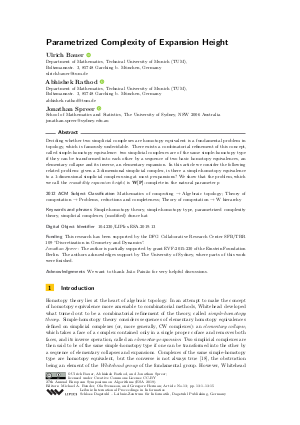Parametrized Complexity of Expansion Height
Authors
Ulrich Bauer  ,
Abhishek Rathod
,
Abhishek Rathod  ,
Jonathan Spreer
,
Jonathan Spreer 
-
Part of:
Volume:
27th Annual European Symposium on Algorithms (ESA 2019)
Part of: Series: Leibniz International Proceedings in Informatics (LIPIcs)
Part of: Conference: European Symposium on Algorithms (ESA) - License:
 Creative Commons Attribution 3.0 Unported license
Creative Commons Attribution 3.0 Unported license
- Publication Date: 2019-09-06
File

PDF
LIPIcs.ESA.2019.13.pdf
- Filesize: 0.53 MB
- 15 pages
Document Identifiers
Subject Classification
ACM Subject Classification
- Mathematics of computing → Algebraic topology
- Theory of computation → Problems, reductions and completeness
- Theory of computation → W hierarchy
Keywords
- Simple-homotopy theory
- simple-homotopy type
- parametrized complexity theory
- simplicial complexes
- (modified) dunce hat
Metrics
- Access Statistics
-
Total Accesses (updated on a weekly basis)
0Document
0Metadata
Abstract
Deciding whether two simplicial complexes are homotopy equivalent is a fundamental problem in topology, which is famously undecidable. There exists a combinatorial refinement of this concept, called simple-homotopy equivalence: two simplicial complexes are of the same simple-homotopy type if they can be transformed into each other by a sequence of two basic homotopy equivalences, an elementary collapse and its inverse, an elementary expansion. In this article we consider the following related problem: given a 2-dimensional simplicial complex, is there a simple-homotopy equivalence to a 1-dimensional simplicial complex using at most p expansions? We show that the problem, which we call the erasability expansion height, is W[P]-complete in the natural parameter p.
Cite As Get BibTex
Ulrich Bauer, Abhishek Rathod, and Jonathan Spreer. Parametrized Complexity of Expansion Height. In 27th Annual European Symposium on Algorithms (ESA 2019). Leibniz International Proceedings in Informatics (LIPIcs), Volume 144, pp. 13:1-13:15, Schloss Dagstuhl – Leibniz-Zentrum für Informatik (2019)
https://doi.org/10.4230/LIPIcs.ESA.2019.13
BibTex
@InProceedings{bauer_et_al:LIPIcs.ESA.2019.13,
author = {Bauer, Ulrich and Rathod, Abhishek and Spreer, Jonathan},
title = {{Parametrized Complexity of Expansion Height}},
booktitle = {27th Annual European Symposium on Algorithms (ESA 2019)},
pages = {13:1--13:15},
series = {Leibniz International Proceedings in Informatics (LIPIcs)},
ISBN = {978-3-95977-124-5},
ISSN = {1868-8969},
year = {2019},
volume = {144},
editor = {Bender, Michael A. and Svensson, Ola and Herman, Grzegorz},
publisher = {Schloss Dagstuhl -- Leibniz-Zentrum f{\"u}r Informatik},
address = {Dagstuhl, Germany},
URL = {https://drops.dagstuhl.de/entities/document/10.4230/LIPIcs.ESA.2019.13},
URN = {urn:nbn:de:0030-drops-111346},
doi = {10.4230/LIPIcs.ESA.2019.13},
annote = {Keywords: Simple-homotopy theory, simple-homotopy type, parametrized complexity theory, simplicial complexes, (modified) dunce hat}
}
Author Details
- Department of Mathematics, Technical University of Munich (TUM), Boltzmannstr. 3, 85748 Garching b. München, Germany
- Department of Mathematics, Technical University of Munich (TUM), Boltzmannstr. 3, 85748 Garching b. München, Germany
Funding
This research has been supported by the DFG Collaborative Research Center SFB/TRR 109 "Discretization in Geometry and Dynamics".
- Spreer, Jonathan: The author is partially supported by grant EVF-2015-230 of the Einstein Foundation Berlin. The authors acknowledges support by The University of Sydney, where parts of this work were finished.
Acknowledgements
We want to thank João Paixão for very helpful discussions.
References
- J. J. Andrews and M. L. Curtis. Free groups and handlebodies. Proc. Amer. Math. Soc., 16:192-195, 1965. URL: https://doi.org/10.2307/2033843.
- Jonathan A. Barmak. Algebraic topology of finite topological spaces and applications, volume 2032 of Lecture Notes in Mathematics. Springer, Heidelberg, 2011. URL: https://doi.org/10.1007/978-3-642-22003-6.
- Ulrich Bauer and Abhishek Rathod. Hardness of approximation for Morse matching. In Proceedings of the Thirtieth Annual ACM-SIAM Symposium on Discrete Algorithms, pages 2663-2674. SIAM, Philadelphia, PA, 2019. URL: https://doi.org/10.1137/1.9781611975482.165.
- Gilbert Baumslag, Alexei G. Myasnikov, and Vladimir Shpilrain. Open problems in combinatorial group theory. Second edition. In Combinatorial and geometric group theory (New York, 2000/Hoboken, NJ, 2001), volume 296 of Contemp. Math., pages 1-38. Amer. Math. Soc., Providence, RI, 2002. URL: https://doi.org/10.1090/conm/296/05067.
-
V. V. Borisov. Simple examples of groups with unsolvable word problem. Mat. Zametki, 6:521-532, 1969.

- Benjamin A. Burton, Thomas Lewiner, João Paixão, and Jonathan Spreer. Parameterized complexity of discrete Morse theory. ACM Trans. Math. Software, 42(1):Art. 6, 24, 2016. URL: https://doi.org/10.1145/2738034.
- R. G. Downey and M. R. Fellows. Parameterized complexity. Monographs in Computer Science. Springer-Verlag, New York, 1999. URL: https://doi.org/10.1007/978-1-4612-0515-9.
-
J. Flum and M. Grohe. Parameterized complexity theory. Texts in Theoretical Computer Science. An EATCS Series. Springer-Verlag, Berlin, 2006.

-
Michael R. Garey and David S. Johnson. Computers and intractability. W. H. Freeman and Co., San Francisco, Calif., 1979. A guide to the theory of NP-completeness, A Series of Books in the Mathematical Sciences.

- Masahiro Hachimori. Combinatorics of constructible complexes. PhD thesis, Tokyo University, 2000. URL: https://pdfs.semanticscholar.org/81ee/09ed08ca6c7487e8e18639a7a05c110781c3.pdf.
-
Allen Hatcher. Algebraic topology. Cambridge University Press, Cambridge, 2002.

- Cynthia Hog-Angeloni and Wolfgang Metzler, editors. Two-dimensional homotopy and combinatorial group theory, volume 197 of London Mathematical Society Lecture Note Series. Cambridge University Press, Cambridge, 1993. URL: https://doi.org/10.1017/CBO9780511629358.
-
Sergei Matveev. Algorithmic topology and classification of 3-manifolds, volume 9 of Algorithms and Computation in Mathematics. Springer, Berlin, second edition, 2007.

-
James R. Munkres. Elements of algebraic topology. Addison-Wesley Publishing Company, Menlo Park, CA, 1984.

- Alexei D. Myasnikov, Alexei G. Myasnikov, and Vladimir Shpilrain. On the Andrews-Curtis equivalence. In Combinatorial and geometric group theory (New York, 2000/Hoboken, NJ, 2001), volume 296 of Contemp. Math., pages 183-198. Amer. Math. Soc., Providence, RI, 2002. URL: https://doi.org/10.1090/conm/296/05074.
- J. Paixão and J. Spreer. Random collapsibility and 3-sphere recognition, 2015. Preprint, 18 pages, 6 figures. URL: http://arxiv.org/abs/1509.07607.
- Martin Tancer. Recognition of collapsible complexes is NP-complete. Discrete Comput. Geom., 55(1):21-38, 2016. URL: https://doi.org/10.1007/s00454-015-9747-1.
- J. H. C. Whitehead. On incidence matrices, nuclei and homotopy types. Ann. of Math. (2), 42:1197-1239, 1941. URL: https://doi.org/10.2307/1970465.
- J. H. C. Whitehead. Simple homotopy types. Amer. J. Math., 72:1-57, 1950. URL: https://doi.org/10.2307/2372133.
- Perrin Wright. Group presentations and formal deformations. Trans. Amer. Math. Soc., 208:161-169, 1975. URL: https://doi.org/10.2307/1997282.
- E. C. Zeeman. On the dunce hat. Topology, 2:341-358, 1964. URL: https://doi.org/10.1016/0040-9383(63)90014-4.
